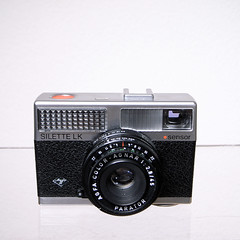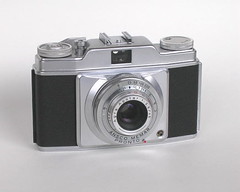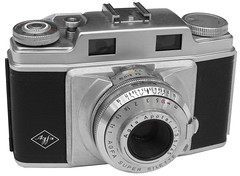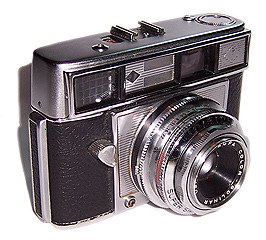Difference between revisions of "Silette"
m (→The first generation: link to Solinar page) |
Hanskerensky (talk | contribs) (→Links) |
||
| (14 intermediate revisions by 4 users not shown) | |||
| Line 1: | Line 1: | ||
| − | '''Silette''' is a name used by the German maker [[Agfa]] from 1953 to 1974 to designate successive generations of [[35mm]] fixed-lens [[viewfinder camera]]s. The corresponding [[rangefinder camera|rangefinder models]] were called '''Super Silette'''. There was also an interchangeable lens rangefinder model called the [[Agfa Ambi Silette|Ambi Silette]], which is discussed elsewhere. The first models were sold in the USA under the name [[Ansco]] Memar and Super Memar, and some of later ones were sold under the name Agfa Solina. | + | '''Silette''' is a name used by the German maker [[Agfa]] from 1953 to 1974 to designate successive generations of [[35mm]] fixed-lens [[viewfinder camera]]s. The corresponding [[rangefinder camera|rangefinder models]] were called '''Super Silette'''. There was also an interchangeable lens rangefinder model called the '''[[Agfa Ambi Silette|Ambi Silette]]''', which used the same body style and is discussed elsewhere. The first models were sold in the USA under the name [[Ansco]] '''Memar''' and '''Super Memar''', and some of later ones were sold under the name Agfa '''Solina'''. |
{{br}} | {{br}} | ||
| Line 6: | Line 6: | ||
|[http://www.flickr.com/photos/89864432@N00/1466254571/in/pool-camerawiki http://farm2.static.flickr.com/1407/1466254571_420db00cc0_t.jpg] | |[http://www.flickr.com/photos/89864432@N00/1466254571/in/pool-camerawiki http://farm2.static.flickr.com/1407/1466254571_420db00cc0_t.jpg] | ||
|[http://www.flickr.com/photos/hamwithcam/5864110990/in/pool-camerawiki http://farm6.staticflickr.com/5315/5864110990_fb881c070f_t.jpg] | |[http://www.flickr.com/photos/hamwithcam/5864110990/in/pool-camerawiki http://farm6.staticflickr.com/5315/5864110990_fb881c070f_t.jpg] | ||
| − | |||
|[http://www.flickr.com/photos/mfobrien/3734214974/in/pool-camerawiki http://farm4.staticflickr.com/3431/3734214974_6b5ebfdce2_t.jpg] | |[http://www.flickr.com/photos/mfobrien/3734214974/in/pool-camerawiki http://farm4.staticflickr.com/3431/3734214974_6b5ebfdce2_t.jpg] | ||
|[http://www.flickr.com/photos/mysteryonionpatch/545239297/in/pool-camerawiki http://farm2.static.flickr.com/1006/545239297_24ff87a0d0_t.jpg] | |[http://www.flickr.com/photos/mysteryonionpatch/545239297/in/pool-camerawiki http://farm2.static.flickr.com/1006/545239297_24ff87a0d0_t.jpg] | ||
| Line 13: | Line 12: | ||
|Super Silette-L | |Super Silette-L | ||
|early Silette | |early Silette | ||
| − | |||
|Solina | |Solina | ||
|Super Silette <small>(early)</small> | |Super Silette <small>(early)</small> | ||
| Line 20: | Line 18: | ||
|[http://www.flickr.com/photos/alf_sigaro/2286109079/in/pool-camerawiki http://farm4.staticflickr.com/3199/2286109079_d94b268d6e_t.jpg] | |[http://www.flickr.com/photos/alf_sigaro/2286109079/in/pool-camerawiki http://farm4.staticflickr.com/3199/2286109079_d94b268d6e_t.jpg] | ||
|[http://www.flickr.com/photos/alf_sigaro/289281788/in/pool-camerawiki http://farm1.staticflickr.com/107/289281788_1fd846440d_t.jpg] | |[http://www.flickr.com/photos/alf_sigaro/289281788/in/pool-camerawiki http://farm1.staticflickr.com/107/289281788_1fd846440d_t.jpg] | ||
| − | |||
|[http://www.flickr.com/photos/alf_sigaro/464292699/in/pool-camerawiki http://farm1.staticflickr.com/210/464292699_cfdcb10a0d_t.jpg] | |[http://www.flickr.com/photos/alf_sigaro/464292699/in/pool-camerawiki http://farm1.staticflickr.com/210/464292699_cfdcb10a0d_t.jpg] | ||
|[http://www.flickr.com/photos/alf_sigaro/280538899/in/pool-camerawiki http://farm1.staticflickr.com/110/280538899_22d89db8b5_t.jpg] | |[http://www.flickr.com/photos/alf_sigaro/280538899/in/pool-camerawiki http://farm1.staticflickr.com/110/280538899_22d89db8b5_t.jpg] | ||
| Line 27: | Line 24: | ||
|Silette with <br/>[[Compur]] shutter | |Silette with <br/>[[Compur]] shutter | ||
|Super Silette SL | |Super Silette SL | ||
| − | |||
|early Silette with<br>Radionar lens | |early Silette with<br>Radionar lens | ||
|Silette Typ E | |Silette Typ E | ||
| Line 61: | Line 57: | ||
|image_by= LucisPictor | |image_by= LucisPictor | ||
|image_rights= with permission | |image_rights= with permission | ||
| − | |||
| − | |||
| − | |||
| − | |||
| − | |||
| − | |||
| − | |||
| − | |||
| − | |||
}} | }} | ||
|} | |} | ||
The first generation of Silette models was produced from 1953 to the early 1960s. | The first generation of Silette models was produced from 1953 to the early 1960s. | ||
| − | The original '''Silette''' appeared in 1953. It is a simple, well-built [[35mm]] camera with a [[viewfinder]], a [[leaf shutter]], a [[film advance|lever wind advance]] and an accessory shoe. The range of shutters | + | The original '''Silette''' appeared in 1953. It is a simple, well-built [[35mm]] camera with a [[viewfinder]], a [[leaf shutter]], a clever flush-fit [[film advance|lever wind advance]], and an accessory shoe. The camera features scale focusing, a film speed reminder in the rewind dial, a self timer built into the rim-set shutter, a tripod mount, and a socket for flash synchronization. The range of shutters extends from the [[Pronto]] (1/25-1/200) to the better [[Compur]] Rapid or Synchro Compur (1/500), with the [[Prontor]] (1/300) in between. The lens is a three-element Color Apotar 3.5/45mm or 2.8/45mm, or a four-element Color [[Solinar]] 2.8/50mm. |
| + | In the USA, the camera was sold as the [[Ansco]] '''Memar'''. On these models the Agfa body labeling is deleted, the name "ANSCO MEMAR" is engraved on the lens lower trim ring instead of "SILETTE", and the focus scale on these models is marked in feet rather than meters, but these cameras are otherwise identical to the corresponding Agfa model. The lenses include the name "Agfa" and were offered with the same configurations as with the Silette. The Memar was also offered as an outfit in a travel case at the special price of $59.95. Included was the camera, camera case, flash unit, and one Anscochrome film.<ref>Seen at an online auction. </ref> | ||
| − | + | As a historical point of interest, the name "Memar" is a carryover from lenses named "Memar" lenses on the [[Agfa_Memo|Agfa Memo]] cameras of the late 1930s, which themselves were named after the [[Ansco_Memo|Ansco Memo]] cameras of the late 1920s and early 1930s. The relationship between Agfa and Ansco, which began in 1928, is documented on the [[Ansco]] page. | |
| + | The original '''Super Silette''' is the same body with a [[coupled rangefinder]]. The Super Silette continued to upgrade the Silette line, and over time additional advanced features were included on the camera. Later models included variable flash synch modes (M and X synch using the same socket, set with a lever), additional LVS setting range marked on lens barrels (up to 60 seconds), and zone focusing markings in addition to the scale focusing markings. The initial range of lenses included the same Color Apotar 45/3.5 or 45/2.8 and Color Solinar 50/2.8, but later a top of the line Color [[Solagon]] 50/2.0 six-element lens was added, with 1/500 sec shutter. Today the original Super Silette with the Color Solagon in the Synchro Compur shutter is considered the most desirable model of the Silette fixed-lens family. | ||
| + | |||
| + | As with the original Silette, in the USA the Super Silette was known as the [[Ansco]] '''Super Memar'''. | ||
| + | |||
| + | {{Flickr_image | ||
| + | |image_source= https://www.flickr.com/photos/90900361@N08/53060340351/in/pool-camerawiki/ | ||
| + | |image= https://live.staticflickr.com/65535/53060340351_e2f7642c76_m.jpg | ||
| + | |image_align= right | ||
| + | |image_text= Silette L | ||
| + | |image_rights= wp | ||
| + | }} | ||
The '''Silette L''', introduced in 1956, has the same body as the viewfinder Silette, but with an uncoupled [[selenium meter]] in the top plate. The camera was made with three successive types of [[light meter|meter]], with a bigger or smaller setting knob, and a larger or smaller cover flap. The shutter and lens combinations are the same as above, except the cheaper Pronto. | The '''Silette L''', introduced in 1956, has the same body as the viewfinder Silette, but with an uncoupled [[selenium meter]] in the top plate. The camera was made with three successive types of [[light meter|meter]], with a bigger or smaller setting knob, and a larger or smaller cover flap. The shutter and lens combinations are the same as above, except the cheaper Pronto. | ||
| Line 103: | Line 102: | ||
|image_rights= non-commercial | |image_rights= non-commercial | ||
}} | }} | ||
| − | After 1959 many Silettes adopted a taller, un-stepped top housing, resembling the fully automatic [[Optima]]: for example, the Super Silette LK. Around 1969 the Silette series adopted Agfa's red "sensor" [[shutter release| release button]] and got a completely squared-off body style. The Silette LK Sensor is a rather late example of a camera using a [[selenium meter]] cell. | + | After 1959 many Silettes adopted a taller, un-stepped top housing, resembling the fully automatic [[Optima]]: for example, the '''Super Silette LK'''. Around 1969 the Silette series adopted Agfa's red "sensor" [[shutter release| release button]] and got a completely squared-off body style. The '''Silette LK Sensor''' is a rather late example of a camera using a [[selenium meter]] cell. |
| + | |||
| + | ==Notes== | ||
| + | <references/> | ||
== Links == | == Links == | ||
| Line 109: | Line 111: | ||
* [http://www.photo-manuals.com/manual/agfa/medium-format-camera/super-silette Agfa Silette Camera Manual :: Photo-Manuals.com] | * [http://www.photo-manuals.com/manual/agfa/medium-format-camera/super-silette Agfa Silette Camera Manual :: Photo-Manuals.com] | ||
* [http://www.flickr.com/photos/rwrede/sets/72157631167797786/ Agfa Silette Repair] by Richard Wrede (railcrew2) | * [http://www.flickr.com/photos/rwrede/sets/72157631167797786/ Agfa Silette Repair] by Richard Wrede (railcrew2) | ||
| − | * [ | + | * [https://www.butkus.org/chinon/agfa/agfa_silette/agfa_silette.htm Agfa Silette PDF manual] at [https://www.butkus.org/chinon/index.html Butkus' OrphanCameras.com] |
| + | * [https://www.butkus.org/chinon/agfa/agfa_silette_i/agfa_silette_i.htm Agfa Silette I PDF manual] at [https://www.butkus.org/chinon/index.html Butkus' OrphanCameras.com] | ||
| + | * [https://www.butkus.org/chinon/agfa/agfa_silette_sl/agfa_silette_sl.htm Agfa Silette SL PDF manual] at [https://www.butkus.org/chinon/index.html Butkus' OrphanCameras.com] | ||
| + | * [https://www.butkus.org/chinon/agfa/agfa_silette_agnar_2-8_3-5/agfa_silette_agnar_2-8_3-5.htm Agfa Silette Agnar 2.8 / 3.5 PDF manual] at [https://www.butkus.org/chinon/index.html Butkus' OrphanCameras.com] | ||
| + | * [https://www.butkus.org/chinon/agfa/agfa_super_silette/agfa_super_silette.htm Agfa Super Silette PDF manual] at [https://www.butkus.org/chinon/index.html Butkus' OrphanCameras.com] | ||
| + | * [https://www.butkus.org/chinon/agfa/agfa_silette_automatic/agfa_silette_automatic.htm Agfa Silette Automatic PDF manual] at [https://www.butkus.org/chinon/index.html Butkus' OrphanCameras.com] | ||
In French: | In French: | ||
* [http://www.collection-appareils.fr/x/html/page_standard.php?id_appareil=1709 Silette type 1 variant], [http://www.collection-appareils.fr/x/html/page_standard.php?id_appareil=68 Silette type 4], [http://www.collection-appareils.fr/x/html/page_standard.php?id_appareil=10343 Silette type 5], [http://www.collection-appareils.fr/x/html/page_standard.php?id_appareil=589 Silette II], [http://www.collection-appareils.fr/x/html/page_standard.php?id_appareil=12320 Silette L], [http://www.collection-appareils.fr/x/html/page_standard.php?id_appareil=10342 Silette LK], [http://www.collection-appareils.fr/x/html/page_standard.php?id_appareil=10339 Super Silette Auto] on [http://www.collection-appareils.fr/general/html/francais.php www.collection-appareils.fr] by Sylvain Halgand | * [http://www.collection-appareils.fr/x/html/page_standard.php?id_appareil=1709 Silette type 1 variant], [http://www.collection-appareils.fr/x/html/page_standard.php?id_appareil=68 Silette type 4], [http://www.collection-appareils.fr/x/html/page_standard.php?id_appareil=10343 Silette type 5], [http://www.collection-appareils.fr/x/html/page_standard.php?id_appareil=589 Silette II], [http://www.collection-appareils.fr/x/html/page_standard.php?id_appareil=12320 Silette L], [http://www.collection-appareils.fr/x/html/page_standard.php?id_appareil=10342 Silette LK], [http://www.collection-appareils.fr/x/html/page_standard.php?id_appareil=10339 Super Silette Auto] on [http://www.collection-appareils.fr/general/html/francais.php www.collection-appareils.fr] by Sylvain Halgand | ||
Latest revision as of 04:57, 14 August 2023
Silette is a name used by the German maker Agfa from 1953 to 1974 to designate successive generations of 35mm fixed-lens viewfinder cameras. The corresponding rangefinder models were called Super Silette. There was also an interchangeable lens rangefinder model called the Ambi Silette, which used the same body style and is discussed elsewhere. The first models were sold in the USA under the name Ansco Memar and Super Memar, and some of later ones were sold under the name Agfa Solina.
The first generation

|

|

|

|

|
| Super Silette-L | early Silette | Solina | Super Silette (early) | Super Silette (later) |

|

|

|

|

|
| Silette with Compur shutter |
Super Silette SL | early Silette with Radionar lens |
Silette Typ E | Silette I |
|
| ||||
|
The first generation of Silette models was produced from 1953 to the early 1960s.
The original Silette appeared in 1953. It is a simple, well-built 35mm camera with a viewfinder, a leaf shutter, a clever flush-fit lever wind advance, and an accessory shoe. The camera features scale focusing, a film speed reminder in the rewind dial, a self timer built into the rim-set shutter, a tripod mount, and a socket for flash synchronization. The range of shutters extends from the Pronto (1/25-1/200) to the better Compur Rapid or Synchro Compur (1/500), with the Prontor (1/300) in between. The lens is a three-element Color Apotar 3.5/45mm or 2.8/45mm, or a four-element Color Solinar 2.8/50mm.
In the USA, the camera was sold as the Ansco Memar. On these models the Agfa body labeling is deleted, the name "ANSCO MEMAR" is engraved on the lens lower trim ring instead of "SILETTE", and the focus scale on these models is marked in feet rather than meters, but these cameras are otherwise identical to the corresponding Agfa model. The lenses include the name "Agfa" and were offered with the same configurations as with the Silette. The Memar was also offered as an outfit in a travel case at the special price of $59.95. Included was the camera, camera case, flash unit, and one Anscochrome film.[1]
As a historical point of interest, the name "Memar" is a carryover from lenses named "Memar" lenses on the Agfa Memo cameras of the late 1930s, which themselves were named after the Ansco Memo cameras of the late 1920s and early 1930s. The relationship between Agfa and Ansco, which began in 1928, is documented on the Ansco page.
The original Super Silette is the same body with a coupled rangefinder. The Super Silette continued to upgrade the Silette line, and over time additional advanced features were included on the camera. Later models included variable flash synch modes (M and X synch using the same socket, set with a lever), additional LVS setting range marked on lens barrels (up to 60 seconds), and zone focusing markings in addition to the scale focusing markings. The initial range of lenses included the same Color Apotar 45/3.5 or 45/2.8 and Color Solinar 50/2.8, but later a top of the line Color Solagon 50/2.0 six-element lens was added, with 1/500 sec shutter. Today the original Super Silette with the Color Solagon in the Synchro Compur shutter is considered the most desirable model of the Silette fixed-lens family.
As with the original Silette, in the USA the Super Silette was known as the Ansco Super Memar.

|
| Silette L (Image rights) |
The Silette L, introduced in 1956, has the same body as the viewfinder Silette, but with an uncoupled selenium meter in the top plate. The camera was made with three successive types of meter, with a bigger or smaller setting knob, and a larger or smaller cover flap. The shutter and lens combinations are the same as above, except the cheaper Pronto.
The Silette SL, made from 1957, was based on the last variant of the Silette L, but the exposure meter is coupled to the aperture and speed settings. The lens is a Color Solinar 2.8/50mm and the shutter is the Prontor SLK to 1/300.
The Silette LK of 1958 is a cheaper variant of the SL, with a Color Apotar 2.8/45mm lens and a Pronto LK 15-250 shutter. Launched the same year, the Silette Automatic (named Silette SLE at the beginning) is better, with the meter reading visible inside and a bright-line viewfinder.
In 1958 the body of the basic Silette model was slightly modified, with an advance lever hidden in the top plate and a larger viewfinder. The cheaper models have a simple viewfinder and the better models a bright-frame one, with a second window to illuminate the frame-lines. Lenses include the Agfa Agnar 3.5/45mm, Color Agnar 2.8/45mm, Color Apotar 2.8/45mm and Color Solinar 2.8/50mm. The shutters are the Pronto, Prontor and Compur Rapid, as well as the Vario B-25-50-200 on the cheapest model. Some of the simpler models were sold in the USA under the name Solina.
One variant of the 1958 basic Silette has a different, elevated top plate that announced the style of the later models.
Prototypes of a Silette Stereo model have been mentioned.
The second generation

|
| Agfa Silette LK Sensor image by Stefan Bucher (Image rights) |
After 1959 many Silettes adopted a taller, un-stepped top housing, resembling the fully automatic Optima: for example, the Super Silette LK. Around 1969 the Silette series adopted Agfa's red "sensor" release button and got a completely squared-off body style. The Silette LK Sensor is a rather late example of a camera using a selenium meter cell.
Notes
- ↑ Seen at an online auction.
Links
In English:
- Agfa Silette Camera Manual :: Photo-Manuals.com
- Agfa Silette Repair by Richard Wrede (railcrew2)
- Agfa Silette PDF manual at Butkus' OrphanCameras.com
- Agfa Silette I PDF manual at Butkus' OrphanCameras.com
- Agfa Silette SL PDF manual at Butkus' OrphanCameras.com
- Agfa Silette Agnar 2.8 / 3.5 PDF manual at Butkus' OrphanCameras.com
- Agfa Super Silette PDF manual at Butkus' OrphanCameras.com
- Agfa Silette Automatic PDF manual at Butkus' OrphanCameras.com
In French:
- Silette type 1 variant, Silette type 4, Silette type 5, Silette II, Silette L, Silette LK, Super Silette Auto on www.collection-appareils.fr by Sylvain Halgand


